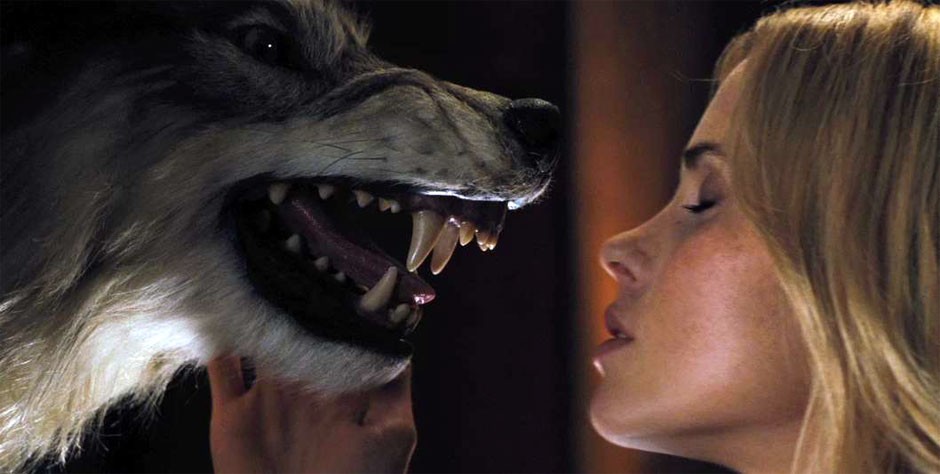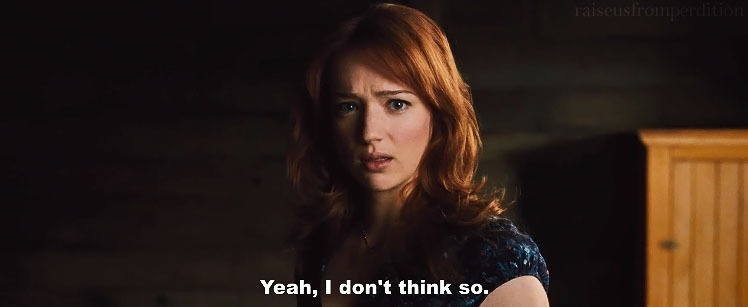This is a guest post from Amanda Rodriguez
Joss Whedon and Drew Goddard’s Cabin in the Woods is a fantastic movie, laying the horror genre bare, critiquing its conventions, and creating a space for a larger cultural conversation. Gender roles (both in and out of horror movies) are a major component of this conversation in which the filmmakers encourage us to engage. Most importantly, the film critiques the virgin/whore dichotomy that cinema and society seem to insist is the only way we can view most women.
A little background info: The scenario in Cabin in the Woods is pretty typical of the horror genre: five college-aged teens spending a weekend at a remote cabin are brutally attacked by a “zombie redneck torture family.” What isn’t typical is that a powerful, secret agency using advanced technology is manipulating the situation in order to complete a sacrificial ritual to ensure the continued slumber of fierce, ancient gods. Yeah, a bit off the beaten path, no?
The sacrifice requires a “transgression” and the resulting deaths of the athlete/jock (Curt), the scholar (Holden), the fool (Marty), and the whore (Jules). The death of the “final girl” aka the virgin (Dana) is optional. Each character is a stand-in for a horror movie archetype. When we examine the two female characters fighting for their lives, we find that they are neither virgin nor whore.
The so-called “whore” is Jules, our heroine’s bubbly best friend and roommate. She is sharp-witted and good-natured, a loyal friend. The agency manipulating the kids is decreasing Jules’ cognitive abilities through a slow-acting chemical compound in her blonde hair dye (she decided to dye her hair on a whim…sounds suspicious to me), and they’ve upped her libido via drugs. As the night progresses, Jules’ behavior becomes more and more out of character.
 |
| Apparently, sexy fireplace dancing and making out with a taxidermied wolf aren’t part of Jules’ normal partying repertoire. |
Jules is the one who must “transgress” by showing her breasts and her willingness to engage in sexual activity, setting off the release of the Buckners (zombie rednecks) to begin the blood sacrifice. When it comes time, though, Jules doesn’t really want to have sex. She and her boyfriend, Curt, are outside, and she wants to go back inside. She’s cold, and it’s too dark. In order to combat Jules’ reservations about having sex, the agency raises the temperature into the 80’s, shines light into a clearing to simulate moonbeams, and floods the area with a pheromone mist.
Though it can’t be said that Jules is forced to transgress, her free will is certainly called into question. Outside forces are influencing her brain, her hormones, and her physical surroundings in such a way that her downfall becomes inevitable. Taken in a larger cultural context, this calls into question the notion that women who like sex or who own their sexuality are whores. It is as if all the women who are judged for some perceived promiscuity are miscast, just like Jules is miscast. Much like the agency, cultural circumstances manipulate women into these roles. A key example of this is how media representations of women replete with their over-sexualization and overt body focus set women up to take the fall in order to fulfill some arcane cultural need. This need seems to go back to (if not predate) the biblical “Fall of Man” where Eve is the transgressor who is blamed for the birth of sin and then punished. Like the horror movie genre, we repeat this same formula over and over again, craving the same result: the transgression and punishment of a woman for her sexuality. Why do we do this? Because it’s a man’s world? Because men are threatened by the power and autonomy of female sexuality? I’m sure all that and more is true, but it’s safe to say it’s definitely a dude thing.
On the other side of the dichotomy coin, we have Dana, the archetypical virgin, who is not actually a virgin.
 |
| The non-virgin virgin. Talk about not really fitting into a gender stereotype. |
Unlike Jules, though, Dana naturally exhibits many of the traits that have cast her in the role of the virgin. She is shy, sexually uncomfortable, brainy, artistic, and somewhat socially awkward. However, as the terrors she must face intensify, Dana has a reserve of strength that aligns her with Carol Clover’s final girl feminist trope. She repeatedly stabs her bear-trap-wielding zombie attacker, Matthew Buckner, with a crowbar and then a knife. She wrestles her way out of the depths of a lake after being attacked by Father Buckner and then withstands an almost inhuman amount of abuse on the dock at the hands of Matthew Buckner. Not only that, but Dana identifies with the killer when she sympathetically reads from the diary of Patience Buckner, thus setting the stage for the ritual by choosing the method of the five friends’ deaths. Also, at the end of the film, in an act that borders on complicity, Patience Buckner stabs The Director (of the agency), and when she does this, Dana sees Patience as her salvation.
In the end, though, Dana doesn’t fit the horror genre virgin role or Clover’s mold because she isn’t the final girl. Marty manages to survive, thus subverting the entire horror genre and the final girl trope in the process. Marty uses his bong invention to rescue Dana from Matthew Buckner before spiriting her away to show her that he’s discovered a subterranean maintenance override panel that he’s hotwired to take them out of their contained, controlled area down into the agency’s headquarters to confront their true tormentors.
 |
| Bong Boy to the rescue! |
Marty is our unlikely hero, which I appreciate, on the one hand, because he is smart, inventive, funny, insightful, and not attractive in the typical Hollywood sense of the word. Even as far as characterization goes, Marty is a far more interesting and engaging protagonist than Dana, who is, frankly, about as fascinating and individualized as linoleum. On the other hand, Marty as the hero making the final decision about whether or not to save our corrupt world subverts the possibility of a feminist reading of the ending. Marty decides that we’re not a species worth saving, and after attempting to shoot him and being bitten by a werewolf, Dana goes along with his choice. Ultimately, Cabin in the Woods is a male fantasy in which the nerd becomes the hero, saving the woman for whom he clearly cares while holding in his hands the power to determine the fate of the world.
It’s dubious whether or not Cabin in the Woods passes the Bechdel Test, as even the final conversation Dana has with The Director is centered around the importance Marty plays in maintaining world order. Without a doubt, the movie is doing many exciting, transgressive things. I find particularly important the way the audience is analogous with “the gods” because we are the ones demanding these elaborate, repetitive sacrifices that push people into these stereotypical roles. It’s not only an indictment of the horror genre but of the voyeuristic spectatorship that perpetuates these horror tropes. However, I expected more from the feminist powerhouse team that created Buffy the Vampire Slayer. I find myself wishing Marty had been cast as a woman, and the two women, the fool and the non-virgin virgin, would be the pair of survivors who finally say “no more” to a horror genre that dismembers, kills, and punishes them for being women. Maybe the world isn’t ready for that, but I’d hoped Joss Whedon and Drew Goddard would be ready to tell us that story anyway.
———-
Amanda Rodriguez is an environmental activist living in Asheville, North Carolina. She holds a BA from Antioch College in Yellow Springs, Ohio and an MFA in fiction writing from Queens University in Charlotte, NC. She writes all about food and drinking games on her blog Booze and Baking. Fun fact: while living in Kyoto, Japan, her house was attacked by monkeys.

Fair disclaimer: I have no degree in Film Studies, nor do I have any kind of official cinematic credentials. I just love movies. That aside, I liked this article even though I don’t entirely agree with everything in it. The concept that I primarily clashed with is the notion,(that I interpreted from the article anyway),that this movie was created with a major feminist viewpoint in mind. Don’t get me wrong, it does have a feminist message in a way, but I think it’s more of a byproduct of a larger idea that just allows Horror movie tropes to take a step back, and laugh at themselves. This movie makes fun of/honors the Horror genre because that’s the point of the movie. The movie is very much conscious that it is making fun of the genre, and that’s why it’s so great. It knows the archetypes are antiquated and over done, that’s why it plays off the characters so well and is a major contributing factor to the film’s charm. The “whore” archetype exists and so do all the others, but they are just so ingrained in human culture in general that we just expect them to be there and we can easily guess their fates. When I see a Horror movie or any movie really and see the archetypes on screen, I identify them easily and guess what’s going to happen because by this point I just expect them. Not because I want to see the actual “whore” character get killed or because I want to see the “virgin” survive, I’ve just watched so many movies that I just expect it to play out in the usual way. And I hate that, it makes me feel like a terrible person and it makes the movies predictable, but it’s just how movies are; if modern movies have taught me anything it’s that Hollywood REALLY doesn’t like to stray from what works. The whole set of archetypes, as awful as they may be, just work in Horror movies because the characters are disposable; you know they’re going to die, so why write an actually like-able character when you can just put in a pre-made one? What works sells, and what sells gets repeated to sell even more.
Personally, I liked seeing Marty survive and become the hero, because if there is one kind of character that gets killed off just as much as the “whore” it’s the “other guy”. You know him, he’s not the jock or the real hero, he’s just the guy that is sort of goofy and is just really there to make a couple of bad jokes in the opening sequence of the movie before he fucks something up and ends dying halfway through. All in all, I still liked the article, I just thought you might have approached the movie from sort of a “wrong” (in the best possible way) mindset. I mean no offense, and I really hope I didn’t offend anyone with my stupid opinion.